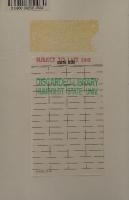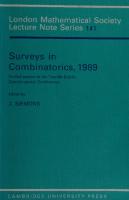Surveys in Combinatorics, 1991 0521407664, 9780521407663
This volume contains the invited papers presented at the British Combinatorial Conference, held at the University of Sur
112 10
English Pages 300 [307] Year 1991
Contents
Preface
1. Construction of signals with favourable correlation properties
2. Old and New Results on Ovals in Finite Projective Planes
3. Schubert Polynomials
4. Computational methods in design theory
5. Fast and slow growing (A combinatorial study of unprovability)
6. Orientations and edge functions on graphs
7. Graph perturbations
8. A Graph Reconstructor's Manual
9. Turán type problems
Recommend Papers
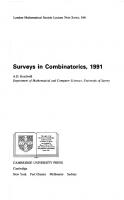
- Author / Uploaded
- A. D. Keedwell
File loading please wait...
Citation preview
London Mathematical Society Lecture Note Series, 166
Surveys in Combinatorics, 1991 A.O. Keedwell Department of Mathematical and Computer Sciences, University of Surrey
u.;.,,,1 , tit, topriJtttlMstll
Tit, ,;,~, of of ~ i t / s t
of boob2, - . . ,bn) be two n-dimensional vectors of real numbers, which could represent two sets of experimental data. The magnitudes of these vectors are la I = Y a-2\ and Ipl = Y b:2\ . The normalized vectors are
l« J
l'-» between J the 1 all A 1*/
7
(1.8)
t
~l
' Proof.
n even
n odd
We proceed as in the proof of Theorem 1, up to maxc,, > V a.- - n k We now observe that each of the m components of
t
IJ
n 1 1 V a.- is a sum of n terms, each of which is either + -==- or — = r . If n is odd, the sum of n such terms cannot be 0, and must have an absolute value of at least -7=-. (For the sum to be 0, half the n terms would have to be + - = - and half — = - , which cannot happen for odd n.) Hence we have n
= m'
1
= 1, from which
max cuJ > ——— (1-/0 = - — . i>;
n(n-l)
n
Hence in this case, n even mm max c.7 all A i*j
Note.
When
J
AZ=4,
the vectors
aj = -=• (1,1,1),
a 3 = -=• (-1,1,-1), a 4 = -j=r (-1,-1,1) have the property
a 2 = -j=r (1,-1,-1),
(a,- a , ) = - y
for all i */.
1.8. Problems 1. Find a set of six binary vectors which achieves the bound of Theorems 1 and 2. (Do not assume that m e2, . . . ,en,-el-e2, e2 = (0,1,0, . . . ,0), ..., en = (0,0,0, . . . , 1). What are the correlation values Cij which occur among this set of vectors? Calculate maxc,-, and average cir How does this relate to Theorem 1? How does it '*; relate to Problem 4 above? (Note. B is an example of what is called a biorthogonal code.) 1.9. Autocorrelation Def. The autocorrelation function C(z) of a function fit) is the correlation between f(t) and / (f+x), regarded as a function of x. It is customary to distinguish three cases: (i) Finite autocorrelation is computed on the assumption t h a t / ( O is identically 0 outside some interval [0J]. This leads to: r-x
J f(t)f(t+x)dt C/(x) = -lj
.
(1.9)
J o (ii) Infinite autocorrelation is computed on the assumption that f(t) is defined for al If, -o© < t < oo, with J \f(t)\2dt
< oo, and we calculate
\f(t)f(t+z)dt Cj{x) = ^
(1.10) 2
1 \f(t)\ dt
(iii) Periodic autocorrelation is computed on the assumption that f(t) is periodic with some period P, so that f(t+P)=f(t) for all t. In this case, we compute p
\f(t)f(t+x)dt
a11) The same concept of autocorrelation applies to sequences. If 5 = {si} is a sequence defined for \ 2, let the rows of H be ai, #2, • • • > an- Multiplying any of the columns of H by — 1 has no effect on the pairwise orthogonality of the rows, nor does any permutation of the columns of H. For convenience, we multiply those columns of if by —1 where ai had a —1, so that in the normalized matrix H', a[ = (+1,4-1,..-,+1). We also permute the columns so that a'2 = ( + 1 , + 1 , . . . , + 1 , - 1 , - 1 , . . . , - 1 ) . Since (-"8 =
r+ + + + + + + + + + - - - + - + + + + - - - + i
l
.4-
and H\2 =
r+ + + + + + +
i
l
+ + - + + - - + - + - + + - -
+ + + + + + - + - + + + - - + - + + + - - + - + - + - - + - - + - - + - - - + - -
-
+ + + + +
4-
1
1
II
+ + + + - - -
+
4-
4-
-J
+ + + + - - + - - - + + - - + + - + + + -4- + +
4 - 4 - - - - 4 - - -
+
-
+- 4 - 4 -
I
i
i
i
i i
+ - -
- 4 - 4 - 4 - - - -
L+ + - + + + - - -
+ -
+ - -
+
+
- -
Examples of this type are called "cyclic Hadamard matrices", and are in one-to-one correspondence with "cyclic Hadamard difference sets". (For an extensive treatment of these, see [G].) All known examples of cyclic Hadamard matrices of order n = At have n — 1 belonging to one of three sequences: a) At - 1 = 2* - 1, Jfc > 1. b) At — 1 = p, p a prime. c) At — 1 = p(p + 2), where p and p + 2 form a twin prime. Examples of type a) can be obtained for all k > 1 by taking the top row of the circulant to be an "m-sequence", i.e. a maximum-length linear shift register sequence, of period 2k - 1, and replacing the O's and l's of the msequence by + T s and —l's, respectively. (For the theory of m-sequences, see [K].) Additional examples of type a), but only for certain composite values of fc, are obtained by the Gordon-Mills-Welch (GMW) construction (see [J]). Examples of type b) can be obtained for all primes p = At — 1 by the "Legendre sequence" construction, taking the top row of the circulant to be
21 where ( | ) is the "Legendre symbol", or "quadratic character", modulo p, defined tor 1 < a < p — 1 by = +1 if for some x,x 2 = a (mod p), = - 1 otherwise. Additional examples of type b) are obtained by Hall's "sextic residue sequence" construction when p = At — 1 = Au2 + 27 (see [H]). If a = 0 (mod p), the Legendre symbol (M is defined to be 0. If p and q are distinct odd primes, the Jacobi symbol ( —) is defined to be ( » ) ( f ) ' ^he product of the Legendre symbols. In the "Legendre sequence construction" for examples of type b), we replaced (-) = 0 with the value —1. To get the "twin prime construction", for cyclic Hadamard matrices of type c) with 4t — 1 = p(p -f 2) = pq, we take the top row of the circulant matrix to be a modification of the sequence of Jacobi symbols { ( £ ) > ( £ ) , ( ; ; ) , • • • ,(*#)} where we use the Jacobi symbol (f-q) whenever this is non-zero; we replace it by -fl for a = {0,^,2^,... , (p — l)q}\ and we replace it by —1 for a = {p, 2p, 3p,... , (q — l)p}. Sequence lengths of types b) and c) are obviously disjoint sets, since no prime is a product of twin primes. The only overlap of lengths of types a) and c) occurs with 2 4 — 1 = 3 - 5 , and here the matrix examples are in fact the same. The overlaps of the sequence lengths of types a) and b) are precisely the Mersenne primes, p = 4t — 1 — 2k — 1. However, the matrix examples are the same only for p = 22 - 1 = 3 and p = 2 3 - 1 = 7, if we are considering m-sequences and Legendre sequences. At p = 25 — 1 = 31, the m-sequence gives the same result as Hall's "sextic residue sequence" construction. At p = 2 7 — 1 = 127, the m-sequence, the Legendre sequence, and the sextic residue sequence constructions all give inequivalent examples. Moreover, at At — 1 = 127, Baumert [G], by complete search, found three more inequivalent examples (thus six inequivalent constructions altogether) which do not form part of any known families. 2.8. Exercises 1. For alH < 100, make a table of the values of At — 1, showing which correspond to the constructions of type a), of type b), of type c), or to no known constructions. 2. Use the Legendre sequence construction to obtain examples of cyclic Hadamard matrices of orders n = 8,n = 12, and n = 20. 3. Use the twin prime construction to obtain examples of cyclic Hadamard matrices of orders n •= 16 and n = 36. 4. Asymptotically, how many sequence lengths At — 1 < x will you find, as x —• co, of each of the three types a), b) and c) ? [It is known that 7r(a:), the number of primes < x, is asymptotic to x/£nx, and that half of these (asymptotically) are of the form At — I. It is not known that
22
the number of twin primes is infinite, but it is conjectured (see[L]) that the number of such pairs up to x, T(x), is asymptotic to cx/£n2x, where c = 2 Ylaii «>2(1 ~" / l\)i) — 1-320... , where the product is extended over all primes p > 2.]
23
CHAPTER 3. APPLICATIONS TO RADAR, SONAR, AND SYNCHRONIZATION 3.1. Overview In all three of the applications mentioned in the title of this chapter, one of the objectives (often the major objective) is to determine a point in time with great accuracy. In radar and sonar, we want to determine the round trip time from transmitter to target to receiver very accurately, because the one-way time (half of the round-trip time) is a measure of the distance to the target (called the range of the target). The simplest approach would be to send out a pure "impulse" of energy, and measure the time until it returns. The ideal "impulse" would be virtually instantaneous in duration, but with such high amplitude that the total energy contained in the pulse would be significant, much like a Dirac "delta function". However, the Dirac "delta function" not only fails to exist as a mathematical function, but it is also unrealizable as a physical signal. Close approximations to it — very brief signals with very large amplitudes — may be valid mathematically, but are impractical to generate physically. Any actual transmitter will have an upper limit on "peak power" output, and hence a short pulse will have a very restricted amount of total energy : at most, the peak power times the pulse duration. More total energy can be transmitted if we extend the duration; but if we transmit at uniform power over an extended duration, we do not get a sharp determination of the round trip time. This dilemma is illustrated in Figure 3.1.
SHORT
LONG
PULSES
. CORRELATIONS -
Figure 3.1. The shorter the pulse, the sharper the autocorrelation function.
24
In the presence of noise, the time of the peak of the autocorrelation function of the extended pulse becomes difficult to determine with high precision. It is here that clever combinatorial mathematics comes to the rescue. By using a suitably coded pulse pattern, or coded signal pattern, we extend the duration, thereby increasing the total transmitted energy as much as desired, while still maintaining a sharp spike in the autocorrelation function to mark the round trip propagation time with great precision. Such a technique was successfully used in 1960 by the Jet Propulsion Laboratory to bounce a radar signal off the surface of Venus and detect it back on earth. Not only was that the first successful radar ranging of another planet in the solar system, but the distance thus measured made it possible to improve the accuracy of the "Astronomical Unit" (the mean radius of the earth's orbit around the sun, and the basic yardstick for distances within the solar system) by three orders of magnitude^ 3.2. Types of Signals and Correlations A monostatic radar is one which has transmitter and receiver at the same location, which requires that the transmitter be turned off while the signal is being received. A bistatic radar is one which has two separate antennas, often at a considerable distance from one another, for transmitting and receiving. With a bistatic radar, it is possible, in principle, to be transmitting all the time. A pulse radar is one which transmits a succession of pulses, not necessarily uniformly spaced, but which is turned off between pulses. A CW (continuous wave) radar is one which stays on the air for an extended period of time, transmitting a sine wave, usually with phase modulation added. A frequency hop radar is one which jumps from one to another of a finite set of frequencies, according to some predetermined pattern, thus combining certain features of the pulse radar and the CW radar. For correlation purposes, most radar patterns are either finite (the transmitter is turned off before and after the pattern is sent) or periodic (the same basic pattern is repeated periodically a number of times). If a CW radar is modulated in both phase and amplitude, the resulting signal can be modelled as a sequence of complex numbers, which also have both phase and amplitude. If only the amplitude varies, the sequence of complex numbers becomes a sequence of real numbers. If only the phase varies, the sequence of complex numbers reduces to a sequence of values on the unit circle of the complex plane. The real line intersects the unit circle at the points +1 and - 1 , and binary modulation by +1 and -1 can be regarded either as phase modulation or as amplitude modulation. The returning signal can be correlated against either an ideal model of itself, or against some other signal (often called a "complementary" signal or sequence), especially designed to highlight some specific feature of the
25
returning signal. In all cases, the ratio of the value of correlation for r = 0, i.e. when the signal is aligned with itself, versus the maximum value of the correlation for r ^ 0, is a measure of the clarity with which range can be measured in a noisy environment. If there is a relative motion (either toward or away) between the transmitter and the target, then the returning radar or sonar signal is shifted not only in time, but also in frequency. The frequency shift ("Doppler shift") is proportional to the time derivative of range — i.e. to the velocity of approach or separation, between communicator and target. The two-dimensional autocorrelation function of the signal, in the time and frequency domains, is called its ambiguity function, and the ideal shape of such a function is a spike, or an inverted thumb-tack (or drawing pin, in the U.K.). 3.3. Barker Sequences R. Barker [M] asked: for what lengths L do binary sequences of +l's and — l's, {ajJJLj, exist, with finite, unnormalized auto-correlation K(r), defined by L-T
(3.1)
K(r)
=
bounded by 1 in absolute value for r ^ 0 ? That is, the requirement is (3.2)
\K(T)\
< l f o r l < | r | < L - 1.
Barker gave examples having the following lengths: L Sequence 1 +1 2 4-1,4-1 3 4-1, + 1 , - 1 4 +1, +1, - 1 , + 1 5 +1,+1,+1,-1,+1 7 +1,+1,+1,-1,-1,+1,-1 11 +1,+1, + 1 , - 1 , - 1 , - 1 , + 1 , - 1 , - 1 , + 1 , - 1 13 +1,+1,+1,+1,+1,-1,-1,+1,+1,-1,+1,-1,+1 Turyn and Storer showed [N] that there are no other "Barker Sequences" for odd lengths L > 13. It is still unproven that even length Barker Sequences with L > 4 do not exist, though this is generally believed. It has been shown (see[I]) that even-length Barker sequences for L > 4 correspond to circulant Hadamard matrices of order L, as described in Section 2.7.
26 3.4 Generalized Barker Sequences In [0], Golomb and Scholtz defined a Generalized Barker Sequence of length L to be a sequence {aj}^=l of complex numbers on the unit circle (that is, \a,j\ = 1 for 1 < j < L) with finite unnormalized autocorrelation K(T), defined by L-T
(3.3)
K(r) =
satisfying (3.4)
\K(T)\
< 1 for
1 < \T\ < L - 1.
In [0], a group of 4L2 transformations on the sequence {aj}^:=l is identified which preserves the "Barker property" (3.4), and examples of Generalized Barker Sequences with L < 16 are given. Subsequently, examples have been found for all lengths L < 19. (See [P], The example given in [P] for L = 19 contains an error, but other examples of this length have been found.) With K(T) defined as in (3.3), K(0) = L, and hence the normalized correlation C(r) for a Generalized Barker Sequence must satisfy (3.5)
|C(T)|
=
i | A ' ( r ) | < ^ , all 1 < | r | < L - 1.
This condition becomes increasingly difficult to satisfy as L increases, and it is extremely unlikely that any Generalized Barker Sequences exist for L > 30 (if indeed they exist for any L > 19). However, for applications to radar, conditions considerably weaker than (3.5) are still quite useful. For example, if {a^JJLj is a sequence for which K(T), as defined in (3.3), satisfies (3.6)
\K(T)\
< cLl'\
l
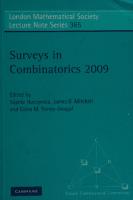
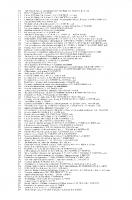
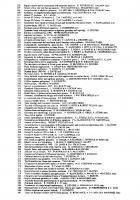

![Surveys in Combinatorics 2021 (London Mathematical Society Lecture Note Series) [New ed.]
1009018884, 9781009018883](https://ebin.pub/img/200x200/surveys-in-combinatorics-2021-london-mathematical-society-lecture-note-series-newnbsped-1009018884-9781009018883.jpg)
